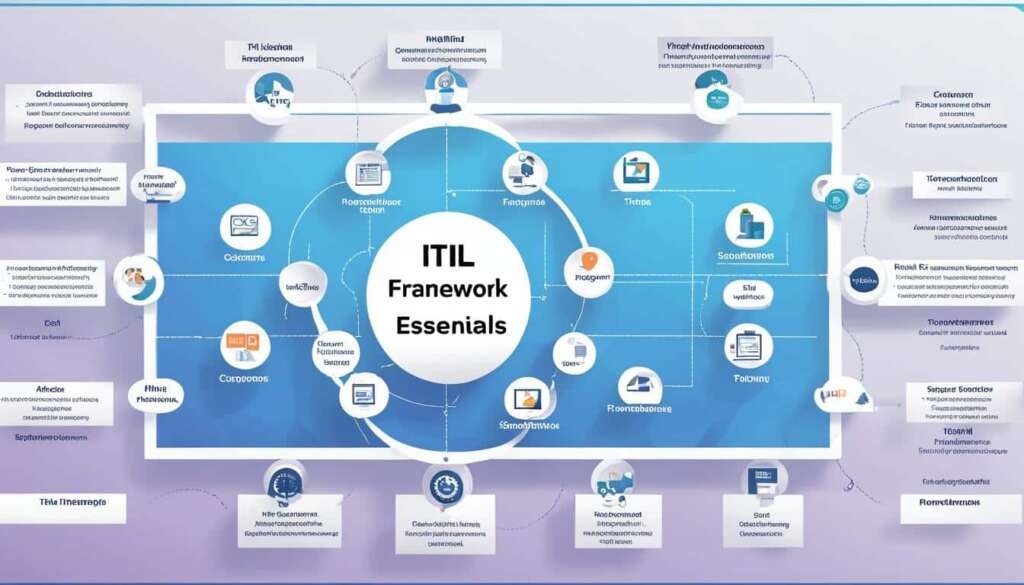Table of Contents
ITIL, which stands for Information Technology Infrastructure Library, is a set of IT best practices designed to align IT services with customer and business needs. It revolutionizes IT service management, helping businesses improve their efficiency and deliver value to customers. ITIL focuses on the management of the IT service lifecycle and provides guidance for service strategy, service design, service transition, service operation, and continual service improvement.
What is ITIL and its Importance in ITSM?
ITIL, which stands for Information Technology Infrastructure Library, is a framework for IT service management. It plays a crucial role in helping organizations align their IT processes with changing business demands, enhancing service levels, reducing costs, and ultimately increasing customer satisfaction.
With ITIL, businesses can optimize current digital technologies and effectively navigate through digital transformations. By implementing ITIL practices, organizations can improve their overall business efficiency and deliver high-quality services that align with their strategic objectives.
The ITIL Definition
ITIL can be defined as a set of best practices that guide organizations in managing their IT services throughout the service lifecycle. These best practices are designed to ensure that IT services are delivered effectively, efficiently, and in line with the needs of the business and its customers.
ITIL provides guidance and processes for various aspects of IT service management, including service strategy, service design, service transition, service operation, and continual service improvement. By following the ITIL framework, organizations can establish a structured approach to IT service management, leading to improved business outcomes.
ITIL helps organizations align their IT processes with changing business demands, improving service levels, reducing costs, and increasing customer satisfaction.
The Importance of ITIL in ITSM
ITIL is of significant importance in the field of IT service management (ITSM). It offers a comprehensive framework that allows organizations to deliver IT services efficiently while maximizing the value provided to the business and its customers.
By aligning IT processes with business objectives, ITIL enables organizations to achieve several benefits:
- Improved Service Levels: ITIL emphasizes delivering high-quality services that meet the needs and expectations of customers. By following ITIL’s best practices, organizations can enhance service levels, resulting in greater customer satisfaction.
- Reduced Costs: ITIL promotes efficiency and optimization in IT service delivery. By streamlining processes and eliminating redundant activities, organizations can reduce costs and achieve greater cost-effectiveness.
- Increased Business Value: Through strategic alignment and effective management of IT services, ITIL helps organizations deliver business value. By focusing on the alignment of IT with business goals, organizations can leverage IT as a strategic asset to drive growth and success.
In summary, ITIL is vital to ITSM as it provides a proven framework for managing IT services and delivering value to the business. By adopting ITIL best practices, organizations can enhance their business efficiency, improve service levels, and achieve optimal business outcomes.
Key Differences Between ITIL and ITSM
While ITIL and ITSM are often used interchangeably, they have distinct differences that are important to understand. ITSM is a paradigm that represents a specific way of understanding the relationship between an IT organization and the business it supports. On the other hand, ITIL is a framework of best practices designed to manage IT services throughout the service lifecycle.
ITSM, which stands for IT service management, encompasses the strategies, processes, and policies that organizations employ to deliver IT services to their customers. It focuses on defining and managing the end-to-end delivery of IT services, ensuring that the IT organization aligns with business goals and objectives. ITSM provides a set of guiding principles for delivering, supporting, and optimizing IT services within an organization.
ITIL, or the IT Infrastructure Library, is a comprehensive framework that provides specific guidance and processes to implement ITSM best practices. ITIL consists of a collection of books, each addressing different aspects and stages of the IT service lifecycle. It offers detailed recommendations for service strategy, service design, service transition, service operation, and continual service improvement. ITIL helps organizations adopt a standardized approach to IT service management, enhancing operational efficiency and ensuring the delivery of high-quality services.
One way to understand the relationship between ITIL and ITSM is to consider ITSM as the overarching paradigm, while ITIL works within that paradigm as a detailed framework for achieving IT service management excellence. ITIL provides the specific tools and processes that organizations can implement to align their IT services with business goals effectively.

Differences Between ITIL and ITSM:
| ITIL | ITSM |
|---|---|
| Framework of best practices | Paradigm for understanding IT service management |
| Focuses on managing IT services throughout the service lifecycle | Encompasses strategies, processes, and policies for delivering IT services |
| Provides specific guidance and processes | Offers guiding principles for IT service delivery and optimization |
| Standardizes IT service management processes | Aligns IT organization with business goals and objectives |
The Evolution of ITIL Framework from V1 to V3
The ITIL framework has undergone significant transformations throughout its history to cater to the changing needs of the industry. Let’s take a closer look at the evolution of ITIL from version 1 to version 3.
ITIL V1: The Beginning of IT Service Management Guidelines
ITIL V1, which was introduced in the late 1980s, provided the initial guidelines for IT service management. It aimed to improve the way IT services were delivered and managed, emphasizing the importance of aligning IT with business objectives.
ITIL V2: A More Structured and Organized Approach
In 2001, ITIL V2 was launched, bringing a more structured and organized approach to IT service management. It introduced separate publications for different IT processes, including service delivery, service support, and security management. This modular approach made it easier for organizations to adopt and implement ITIL best practices.
ITIL V3: Focus on the IT Service Lifecycle
Building on the success of ITIL V2, ITIL V3 was released in 2007. It emphasized the IT service lifecycle and provided comprehensive guidance for each stage of the lifecycle. These stages included service strategy, service design, service transition, service operation, and continual service improvement.
By focusing on the entire IT service lifecycle, ITIL V3 aimed to improve service quality, increase customer satisfaction, and drive continuous improvement within IT service management.
| ITIL Version | Year Released | Main Focus |
|---|---|---|
| ITIL V1 | Late 1980s | IT service management guidelines |
| ITIL V2 | 2001 | Structured approach to IT service management |
| ITIL V3 | 2007 | IT service lifecycle and continual improvement |
As the table above demonstrates, each version of the ITIL framework has evolved to address the changing needs and challenges of IT service management. The transition from V1 to V2 introduced a more structured approach, and V3 further enhanced this by focusing on the entire IT service lifecycle.
The evolution of the ITIL framework has paved the way for organizations to adopt industry best practices in managing their IT services. By embracing the latest version of ITIL, businesses can improve operational efficiency, enhance service quality, and achieve better alignment between IT and business goals.
ITIL V3: The Five Stages of the IT Service Lifecycle
ITIL V3 introduced a comprehensive approach to IT service management, encompassing the entire service lifecycle. The ITIL service lifecycle consists of five stages, each playing a vital role in delivering high-quality IT services that align with business objectives.
1. Service Strategy
Key Processes: Service Portfolio Management, Demand Management, Financial Management for IT Services
In the service strategy stage, organizations define their IT service strategy based on business needs and goals. This involves identifying new service opportunities, managing the service portfolio, and ensuring appropriate financial planning for IT services.
2. Service Design
Key Processes: Service Level Management, Service Catalogue Management, Availability Management
During the service design stage, organizations design new IT services or modify existing ones to meet the agreed requirements. This includes defining service levels, creating service catalogues, and ensuring service availability, capacity, and continuity.
3. Service Transition
Key Processes: Change Management, Release and Deployment Management, Knowledge Management
The service transition stage focuses on transitioning new or modified services into operation. This involves managing changes, planning and implementing releases, and ensuring that knowledge is effectively transferred to support teams.
4. Service Operation
Key Processes: Incident Management, Problem Management, Service Desk
In the service operation stage, IT services are delivered and supported on a day-to-day basis. This includes managing incidents, problems, and service requests, as well as maintaining service levels and customer satisfaction.
5. Continual Service Improvement
Key Processes: Service Measurement and Reporting, Service Portfolio Improvement, Process Evaluation
The continual service improvement stage focuses on identifying areas for improvement in IT services and processes. This includes measuring and reporting service performance, evaluating processes, and implementing changes to enhance efficiency and effectiveness.
By following the ITIL service lifecycle, organizations can ensure that their IT services are aligned with business objectives, deliver value to customers, and continually improve over time.
The Benefits and Use Cases of ITIL Framework
Organizations that adopt the ITIL framework can reap numerous benefits to enhance their IT service management. The standardization of IT processes facilitated by ITIL improves predictability and efficiency, leading to smoother operations and better service delivery. By enhancing transparency, ITIL provides organizations with increased visibility into IT costs and operations, enabling better decision-making and cost control.
One of the key advantages of ITIL is its ability to align IT services with business strategies. By integrating ITIL practices, organizations can ensure that their IT initiatives support and contribute to the achievement of their overall business goals. This alignment not only enhances cost-effectiveness but also enables strategic decision-making, helping organizations stay ahead in today’s competitive market.
The benefits of ITIL are not limited to a particular organization size or industry. Whether small or large, ITIL provides a flexible roadmap for organizations to navigate digital transformations. It offers guidance for effectively managing IT services and optimizing existing digital technologies to drive organizational productivity and customer satisfaction.
Use Cases of ITIL
ITIL finds extensive use in various IT service management scenarios. Some notable use cases include:
Implementing Incident Management: ITIL can be applied to streamline and improve incident management processes, reducing downtime and minimizing business disruption.
Enhancing Change Management: ITIL helps organizations effectively plan, implement, and track changes, ensuring minimal risk and maximum efficiency during the change process.
Improving Service Desk Operations: By adopting ITIL practices, service desk operations can be standardized, enabling faster response times, better incident resolution, and improved customer satisfaction.
Enabling Effective Problem Management: ITIL enables organizations to proactively identify and address underlying causes of recurring problems, preventing issues from recurring and driving continuous improvement.
Supporting Service Level Management: ITIL provides the necessary frameworks and processes to define, negotiate, and manage service level agreements, reinforcing customer satisfaction and improving service quality.
With its proven benefits and broad use cases, ITIL continues to be a valuable framework for organizations across industries seeking to optimize their IT service management and achieve operational excellence.
Putting ITIL into Practice: ITIL 4 and ITIL Certification
ITIL 4 represents the latest version of the revered ITIL framework, encompassing the most up-to-date trends and best practices in IT service management. With a focus on delivering valuable IT services, ITIL 4 introduces the four-dimension model and the ITIL Service Value System. This comprehensive approach equips ITSM professionals with the tools and knowledge to drive organizational success.
For IT professionals looking to gain technical and practical expertise in implementing ITIL practices, ITIL certification is available. By becoming ITIL certified, professionals can enhance their skills and broaden their knowledge base. This certification empowers individuals to navigate the complexities of IT service management effectively, enabling them to improve organizational efficiency and boost service delivery.
ITIL 4 and ITIL certification offer ITSM professionals a pathway to success in today’s ever-evolving digital landscape. With ITIL 4’s comprehensive framework and the technical prowess gained through certification, professionals can steer their organizations towards efficient IT service management practices, ensuring they stay ahead in the competitive business landscape of the digital age.
FAQ
What is ITIL and how does it relate to IT service management?
ITIL, which stands for Information Technology Infrastructure Library, is a framework of best practices for managing IT services throughout their lifecycle. It aims to align IT processes with customer and business needs, enhancing business efficiency and service quality.
What are the key differences between ITIL and ITSM?
ITSM is a paradigm, a specific way of understanding the relationship between the IT organization and the business it supports. ITIL, on the other hand, is a framework of best practices for managing IT services. While both focus on delivering IT services aligned with business goals, ITIL provides specific guidance and processes within the ITSM paradigm.
How has the ITIL framework evolved over the years?
The ITIL framework has evolved from its first version, ITIL V1, released in the late 1980s, to the latest version, ITIL V3. Each version introduced new elements and processes to meet changing industry needs and enhance IT service management practices.
What are the five stages of the ITIL service lifecycle?
The five stages of the ITIL service lifecycle are service strategy, service design, service transition, service operation, and continual service improvement. Each stage has its own set of processes and objectives, working together to deliver high-quality IT services aligned with business objectives.
What are the benefits of implementing the ITIL framework?
Implementing the ITIL framework allows for standardization of IT processes, improving predictability and efficiency. It enhances transparency by providing visibility into IT costs and operations. ITIL helps organizations align their IT services with business strategies, leading to cost-effectiveness and strategic alignment.
What is ITIL 4 and how does it relate to ITIL certification?
ITIL 4 is the latest version of the ITIL framework and incorporates the latest trends and best practices in IT service management. ITIL certification is available for IT professionals who want to gain technical and practical knowledge in implementing ITIL practices. It helps professionals enhance their skills, improve organizational efficiency, and drive successful IT service management.












